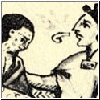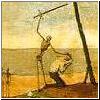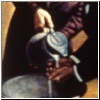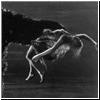|
Evolutionary Epidemiology: an Art Gallery |
|
 |
Anonymous, 1330.
Anjou Legendarium. Vatican Library, Vatican City.
In the final scene
of the Legend of Saint Ladislaus, the King rests in the arms of the girl
he has just saved from a Cuman warrior. The girl "looks into the head"
of the King. |
|
 |
Jan van Eyck: The
Arnolfini Marriage (The Marriage of Giovanni Arnolfini and Giovanna
Cenami) 1434. Oil on wood, 81.8 * 59.7 cm; National Gallery, London
Why do we
reproduce sexually? Being males and females, or men and women, most
living organisms reproduce sexually. Thus, we can produce only half as
many offspring as the yield of an asexual population consisting of
females only. Apparently, sexuality emerged and became the dominant way
of reproduction in the living world due to the selection pressure
exerted by pathogens. The offspring produced sexually are more resistant
against infections than the offspring produced non-sexually. However,
pathogens utilise our sexuality to enhance their own transmission, and
they also reproduce themselves sexually so as to produce offspring more
resistant against the attacks of our immune systems. |
|
 |
Albrecht Dürer:
Four Horsemen of Apocalypse, 1498. Woodcut, 39 * 28 cm
Through human
history, war always coincided with epidemics. |
|
 |
Aztec smallpox
victims. Bernardino de Sahagún: Historia De Las Cosas de Nueva Espana,
Volume 4, Book 12.
In 1519, Hernando
Cortez landed in Mexico. Together with his 4-600 men, and the smallpox
they carried accidentally, he destroyed the powerful Aztec Empire within
two years. When he arrived, about 25-30 million natives inhabited the
region. Half a century later, 3 million native people survived. |
|
 |
Pieter Bruegel:
The Triumph of Death, 1562. Oil on panel, 117 * 162 cm; Museo del Prado,
Madrid
The view of Europe
during a medieval plague epidemic. Yersinia pestis bacteria normally
occur in rodents but fleas may occasionally transmit them into human
populations where they can establish self-sustainable epidemics. The
disease originates from Central and East Asia and first appeared in
Europe in 1346 among the tatar forces sieging the town of Caffa in the
Crimea. The tartars used catapults to hurl human plague cadavers into
the town, from where the defenders fled by ships toward the
Mediterranian. The first European plague epidemic emerged in Southern
Europe in the next year and eradicated 30% of the European population
soon. |
|
 |
Jan Vermeer: The
Milkmaid, 1658-60. Oil on canvas, 18 * 16 in. Rijksmuseum, Amsterdam
Humans
domesticated the wild ox (Bos taurus) to ensure a safe access to the
milk of cows, thus, accidentally, also opened a way to the bacteria of
tuberculosis (Mycobacterium tuberculosis) to invade humans. Once one of
the most important human diseases, tuberculosis is now greatly decimated
by "pasteurisation" and the widespread use antibiotics. Not forever,
unfortunately. New, drug-resistant strains are spreading globally and
especially in the former Soviet Union. Prisoners, refugees, homeless
people and AIDS-patients are at particular risk. |
|
 |
Gerard ter Borch:
The Family of the Stone Grinder, 1653-55, Oil on canvas, Staatliche
Museen, Berlin
For the wast
majority of humankind, lousyness was (is) not a horryfying infestation
but the nurmal way of life. Head lice was (is) more widespread among
children, wny body lice was widespread among adults as well. |
|
 |
Jan Vermeer van
Delft: Girl with a Pearl Earring. circa 1665. Oil on canvas, 44,5 * 39
cm, Mauritshuis, Hága, Hollandia
Animals
exhibit sevaral adaptions to identify, to encapsulate and to kill any
non-self materilas – and pathogens in particular – entering into their
bodies. The immune system of vertabrates is particularly complex.
However, animals with much simpler body structures and shorter lifes
tend to apply simple defenses. Mulluscs, such as bivalves, clams,
oysters or mussels, simply develop a hard calcium carbonate layer to
encapsulate any non-self material entering their bodies.
|
|
 |
Gerard ter Borch:
Boy Ridding his Dog of Fleas, c. 1665, Oil on canvas, 34,4 * 27,1 cm,
Alte Pinakothek, Munich. |
|
 |
Anton Einsle:
Portrait of Ferenc Kölcsey. Hungarian Academy of Sciences, Budapest.
Typically, there
is a negative trade-off between virulence and transmission capability of
pathogens; thus the most virulent pathogens tend to transmit poorly. The
smallpox virus, however, was an exception; it was highly contagious
while it could permanently cause a mortality rate of about 30% in the
European population. Survivors often became blind due to infection. The
last infected human was a Somalian peasant in 1973, but stocks of the
smallpox virus are still maintained for military purposes.
|
|
 |
Eugéne Delacroix:
Medea is about to kill her children, 1838. Oil and canvas, Louvre,
Paris.
According to Greek
mythology, Medea killed her children when her husband left her. Can
natural selection favour such extreme acts of spite? Some of us believe
that Hamiltonian spite, i.e. harming conspecifics without a direct
benefit, does exist in Nature. Some animals actively infest conspecifics
by the pathogens reproducing in themselves. |
|
 |
Alfred Rethel:
First outbreak of the cholera in Paris during a masquerade, 1851.
Cholera became
known and respected probably since medieval urbanisation. It is
transmitted by drinking water, causes dysentery and thus a potentially
lethal dehydration of the human body. The disease has not got a chronic
form, but the pathogenic Vibrio cholerae bacteria may live, feed and
multiply themselves in aquatic reservoirs such as in Chironomid egg
masses. Cholera outbreaks still cause epidemics with high human
mortality in developing countries. |
|
 |
John Tenniel:
Alice and the Red Queen running hand in hand, 1871. Illustration for L.
Carroll: Through the Looking Glass and What Alice Found There.
Wood-engraving
"...they were
running hand in hand, and the Queen went so fast that it was all she
could do to keep up with her...The most curious part of the thing was,
that the trees and the other things around them never seemed to changed
their places at all..." According to Carroll's tale, the Red Queen is a
chess-piece who has to run continuously to keep her position in a
running world. Is the co-evolution of hosts and parasites a similar run
to achieve a constant position in a world running around us?
|
|
 |
Arnold Boecklin:
The Plague. 1898. Tempera on wood, 149 *105 cm, Kunstmuseum Basel,
Basle.
Plague often
inspired human imagination. The soviet Biopreparat started to produce
freeze–dried plague bacteria from the early 1970s. This company
employed 6.500 scientists and 25.000 workers who were — officially —
producing vaccines for peaceful purposes only. A military excersice to
test these products on the remote "Rebirth" island of lake Aral killed
about 500.000 saiga antelopes on the nearby Turgay steppe in 1988. Then
the so-called "super-plague" was already weaponised for large-scale
military use. This was a genetically modified version of Yersinia pestis
having an increased virulence and being resistant against antibiotics.
After repeated unveilings President Yelcin prohibited offensive
bio-weapon developments. |
|
 |
Robert Thom:
Semmelweis —
Defender of Motherhood. 1966.
Neither doctors,
nor medicines, but hand-washing spares most human lives from contagious
diseases. In the 19th century, mortality of healthy women was about 18%
in the delivery room of the Vienna City Hospital, Austria. This was
reduced to about 3% by introducing obligatory hand-washing for the
medical personnel by Dr. Semmelweis, a Hungarian medical doctor. He was
forced to leave because he made a bad reputation for the Hospital by his
'ridiculous and groundless' claim that the puerperal sepsis was caused
by unvisible little creatures transmitted by the hands of the medical
personnel. Soon he died due to a contagious disease, a disease of the
same kind he was fighting against.
|
|
 |
Underwood &
Underwood: U.S. inspectors examining eyes of immigrants looking for
signs of trachoma. 1913. b&w film copy negative, Ellis Island, New York
Harbor.
Immigrants, unlike
the local majority, tend to transmit pathogens to genetically
non-related individuals. Evolutionary theory predicts that under such
circumstances, organisms can benefit from enhancing pathogen
transmission to conspecifics. Consequently, when behaving instinctively,
immigrants are predicted to transmit pathogens more readily than the
so-called ethnic majority. On the other hand, when behaving
instinctively, the majority is predicted to show counter-adaptations,
such as xenophobia to exclude immigrants from the context of social
relations. When behaving instinctively, they are predicted to blame
immigrants for transmitting pathogens either ignorantly or purposely,
even without any cause for such denouncing accusations. The immigration
law of 1891 made it mandatory that all immigrants coming into the United
States be given a health inspection. At Ellis Island, however, only
those who traveled in third class had to pass through the inspection. |
|
 |
The execution of
Margaretha Geertruida Zelle alias Mata Hari.
Press photo,
authenticity debated. Casernes de Vincennes, 1917.
Well
hidden in our usual body structure, pathogens and parasites pretend to
be normal components of our bodies. Meanwhile, they profitise on
monopolising the nutrients and other resources of our bodies, and
manipulate our behaviours in their own interest. And they also risk to
face the most severe punishment if identified as non-selfs by our immune
systems. Like spies uncovered. |
|
 |
Edvard Munch: After Spanish Flu, self
portrait, 1919.
Spanish flu was an
influenza pandemic caused by an unusually deadly variant of Influenza A
subtype H1N1. It killed about 50 (estimates: 20-100) million people
between 1918-1920. It soon went extinct globally, however, nowadays it
is possible to synthesized it de novo. |
|
 |
RKO Radio Pictures: King Kong "The
Eighth Wonder of the World", 1933. 100 mins, 35 mm black and white
negative, USA. (Originally titled: The Beast, King Ape, and Kong)
According to this
movie, inhabitants of the remote Skull Island sacrificed a young virgin
to the monster called Kong each year, in order to safe themselves from
greater losses. Does it worth for animals to sacrifice a limited amount
of space and nutrients to parasites so as to ensure that no more harm
will be caused? Studies on reptiles that develop specific "mite-sacs" to
hide and feed their blood-sucking Trombiculid mites appear to support
this view.
|
|
 |
Perpetual Peacock Painting, 19 * 28", by
Loretta Casler, wc, wc pencil, gouache.
William Hamilton
and Marlene Zuk hypothesized that female birds' preference for males
with particularly large and bright secondary sexual characters improves
the genetic quality of their offspring. Brighter males have had fewer
parasites while developing their plumage, because they harbour better
resistance alleles than their duller rivals. Testosterone, the hormone
regulating the development of these sexual signals, is
immune-suppressive. Thus males who try to cheat by developing plumages
sexier than they can afford will fall due to infections. Indeed, chicks
fathered by brigther peacocks exhibit a lower level of mortality.
|
|